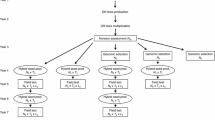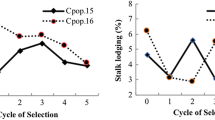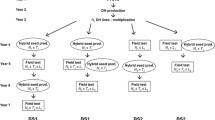Summary
An experiment was conducted in Winnipeg, Manitoba, Canada to: (1) ascertain the efficiency of gridded mass selection; (2) to determine if additional selection efficiency can be achieved through refinement of the gridded mass selection procedure; and (3) to determine if the degree of homozygosity has an effect on response to single-plant selection. Three selection methods [simple mass selection (SMS); gridded mass selection (GMS); and a new rhombic grid selection (RGS)] were applied to four populations [a conventional F2 (CON-F2); an intermated F2 (INT-F2); and 2 partial backcrossed populations] developed from a biparental cross involving the Canadian spring wheat cultivars, ‘Glenlea’ and ‘Sinton’. Averaged over the 4 populations, a single cycle of RGS (10% selection intensity) increased yield by about 9.5%, whereas GMS and SMS increased yield by approximately 4.5% and 3.1%, respectively. The degree of homozygosity of individual plants that make up the population appeared to have an effect on the efficiency of selection. In general, selection was more efficient in the two partial backcrossed populations, and least efficient in the CON-F2 and INT-F2 populations. The largest response to selection (15.9%) was attained when RGS was applied in the backcross to Glenlea population, and the lowest response (1.2%) when SMS was enforced in the CON-F2 population. This paper represents the first report on the efficiency of rhombic grid selection for yield improvement in cereal crops.
Similar content being viewed by others
References
Allard R.W., 1960. Principles of Plant Breeding. John Wiley and Sons, Inc., New York.
Brim C.A. & C.C. Cockerham, 1961. Inheritance of quantitative characters in soybeans. Crop Sci 1: 187–190.
Fasoulas A., 1973. A new approach to breeding superior yielding varieties. Dept of Genetics and Plant Breeding Pub. No. 3, Aristotellian Univ of Thessoloniki, Greece.
Fisher, R.A., 1978. Are your results confounded by intergenotypic competition? Proc 5th Int Wheat Genet Symp, New Delhi, pp 767–777.
Gardner C.O., 1961. An evaluation of effects of mass selection and seed irradiation with thermal neutrons on yield of corn. Crop Sci 1: 241–245.
Grafius J.E., W.L. Nelson & V.A. Dirks, 1952. The heritability of yield in barley as measured by early generation bulk progenies. Agron J 44: 253–257.
Guthrie D.A., E.L. Smith & R.W. McNew, 1984. Selection for high and low grain protein in six winter wheat crosses. Crop Sci 24: 1097–1100.
Hanson W.D., 1959. The breakup of initial linkage blocks under selected mating systems. Genet 44: 857–868.
Johnson G.R. & K.G. Frey, 1967. Heritability of quantitative traits of oats (Avena spp.) at varying levels of environmental stress. Crop Sci 7: 43–46.
Khalifa M.A. & C.O. Qualset, 1975. Intergenotypic competition between tall and dwarf wheats. II. In hybrid bulks. Crop Sci 15: 640–644.
Lonnquist J.H., O. Cota A. & C.O. Gardner, 1966. Effect of mass selection and thermal neutron irradiation on genetic variances in a variety of corn (Zea mays L.). Crop Sci 6: 330–332.
Lothrop J.E., R.E. Atkins & O.S. Smith, 1985. Variability for yield and yield components in IAP1R grain sorghum randommating population. II. Correlations, estimated gains from selection, and correlated responses to selection. Crop Sci 25: 240–244.
Mitchell J.W., R.J. Baker & D.R. Knott, 1982. Evaluation of honey comb selection for single-plant yield in durum wheat. Crop Sci 22: 840–843.
Nass H.G., 1978. Comparison of selection efficiency for grain yield in two population densities of spring wheat crosses. Crop Sci 18: 10–12.
Onim J.F.M., 1981. Effects of two population improvement methods on grain yield of pigeon pea composite populations in Kenya. Euphytica 30: 271–275.
Pederson D.G., 1974. Arguments against intermating before selection in self-fertilizing species. Theor Appl Genet 45: 157–162.
Shebeski L.F., 1967. Wheat and Breeding. In: K.F. Nelson, Proc Can Centernnial Wheat Symp. Modern Press, Saskatoon, Saskatchewan, Canada.
Shebeski, L.F. & L.E. Evans, 1973. Early generation selection for wide-range adaptability in the breeding program. Proc 4th Internat Wheat Genet Symp Missouri Agric Ext Stn, Colombia, MO, pp 587–593.
Sneep J., 1977. Selection for yield in early generations of self-fertilizing crops. Euphytica 26: 27–30.
Steel R.G.D. & J.H. Torrie, 1960. Principles and Procedures of Statistics. McGraw-Hill Book Co., New York.
Torrie J.H., 1962. Comparisons of hills and rows for evaluating soybean strains. Crop Sci 2: 47–49.
Verhalen L.M., J.L. Baker & R.W. McNew, 1975. Gardner's grid system and plant selection efficiency in cotton. Crop Sci 15: 588–591.
Author information
Authors and Affiliations
Additional information
Contribution No. 550 of Agriculture Canada, Lacombe Research Station, Bag Service 5000, Lacombe, Alberta, Canada TOC ISO
Rights and permissions
About this article
Cite this article
Kibite, S. An evaluation of a new rhombic grid selection, gridded mass selection and simple mass selection methods for yield improvement in wheat. Euphytica 38, 143–148 (1988). https://doi.org/10.1007/BF00040185
Received:
Accepted:
Issue Date:
DOI: https://doi.org/10.1007/BF00040185




